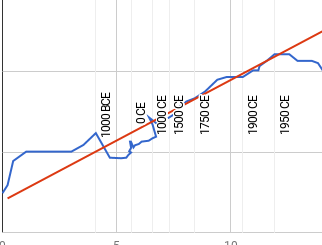Published Feb 7 2020
We do not know if breech loading rifles represented a discontinuity in military strength. They probably did not represent a discontinuity in fire rate.
Details
This case study is part of AI Impacts’ discontinuous progress investigation.
We have not investigated this topic in depth. What follows are our initial impressions.
Background
A breechloader[1][2] is a firearm in which the cartridge or shell is inserted or loaded into a chamber integral to the rear portion of a barrel.
Modern mass production firearms are breech-loading (though mortars are generally muzzle-loaded), except those which are intended specifically by design to be muzzle-loaders, in order to be legal for certain types of hunting. Early firearms, on the other hand, were almost entirely muzzle-loading. The main advantage of breech-loading is a reduction in reloading time – it is much quicker to load the projectile and the charge into the breech of a gun or cannon than to try to force them down a long tube, especially when the bullet fit is tight and the tube has spiral ridges from rifling. In field artillery, the advantages were similar: the crew no longer had to force powder and shot down a long barrel with rammers, and the shot could now tightly fit the bore (increasing accuracy greatly), without being impossible to ram home with a fouled barrel.
Trends
Breech loading rifles were suggested to us as a potential discontinuity in some measure of army strength, due to high fire rate and ability to be used while lying down. We did not have time to investigate this extensively, and have not looked for evidence for or against discontinuities in military strength overall. That said, the reading we have done does not suggest any such discontinuities.
We briefly looked for evidence of discontinuity in firing rate, since firing rate seemed to be a key factor of any advantage in military strength.
Firing rate
Upon brief review it seems unlikely to us that breech loading rifles represented a discontinuity in firing rate alone. Revolvers developed in parallel with breech-loading rifles, and appear to have had similar or higher rates of fire. This includes revolver rifles, which (being rifles) appear to be long-ranged enough to be comparable to muskets and breech-loading rifles.2
The best candidate we found for a breech loading rifle constituting a discontinuity in firing rate is the Ferguson Rifle, first used in 1777 in the American Revolutionary War.3 It was expensive and fragile, so it did not see widespread use;4 breech-loading rifles did not become standard in any army until the Prussian “Needle gun” in 1841 and the Norwegian “Kammerlader” in 1842.5 Both the Ferguson and the Dreyse needle gun could fire about six rounds a minute (sources vary),6 but by the time of the Ferguson well-trained British soldiers could fire muskets at about four rounds a minute.7 Moreover, apparently there are some expensive and fragile revolvers that predate the Ferguson, again suggesting that breech-loading rifles did not lead to a discontinuity in rate of fire.8 All in all, while we don’t have enough data to plot a trend, everything we’ve seen is consistent with continuous growth in firing rate.
Other metrics
It is still possible that a combination of factors including fire rate contributed to a discontinuity in a military strength metric, or that a narrower metric including fire rate saw some discontinuity.
Thanks to Jesko Zimmerman for suggesting breech-loading rifles as a potential area of discontinuity.
Notes
“Breechloader.” In Wikipedia, May 14, 2019. https://en.wikipedia.org/w/index.php?title=Breechloader&oldid=897060135.- For an example of a revolver rifle in use at roughly the same time as the Dreyse needle gun, the first breech-loading rifle to get widespread uptake, see the Colt New Model Revolving Rifle. Quote: “Revolving rifles were an attempt to increase the rate of fire of rifles by combining them with the revolving firing mechanism that had been developed earlier for revolving pistols. Colt began experimenting with revolving rifles in the early 19th century, making them in a variety of calibers and barrel lengths.” “Colt’s New Model Revolving Rifle.” Wikipedia. April 16, 2019. Accessed April 19, 2019. https://en.wikipedia.org/wiki/Colt’s_New_Model_Revolving_rifle.
- “The Ferguson rifle was one of the first breech-loading rifles to be put into service by the British military. It fired a standard British carbine ball of .615″ calibre and was used by the British Army in the American War of Independence at the Battle of Saratoga in 1777, and possibly at the Siege of Charleston in 1780.[1]” – “Ferguson Rifle.” Wikipedia. March 09, 2019. Accessed April 29, 2019. https://en.m.wikipedia.org/wiki/Ferguson_rifle.
- “The two main reasons that Ferguson rifles were not used by the rest of the army: The gun was difficult and expensive to produce using the small, decentralized gunsmith and subcontractor system in use to supply the Ordnance in early Industrial Revolution Britain. The guns broke down easily in combat, especially in the wood of the stock around the lock mortise. The lock mechanism and breech were larger than the stock could withstand with rough use. All surviving military Fergusons feature a horseshoe-shaped iron repair under the lock to hold the stock together where it repeatedly broke around the weak, over-drilled out mortise.” – “Ferguson Rifle.” Wikipedia. March 09, 2019. Accessed April 29, 2019. https://en.m.wikipedia.org/wiki/Ferguson_rifle.
- “The Kammerlader, or “chamber loader”, was the first Norwegian breech-loadingrifle, and among the very first breech loaders adopted for use by an armed force anywhere in the world.” “Kammerlader.” Wikipedia. January 07, 2019. Accessed May 01, 2019. https://en.wikipedia.org/wiki/Kammerlader.
“Dreyse Needle Gun.” Wikipedia. March 09, 2019. Accessed May 01, 2019. https://en.wikipedia.org/wiki/Dreyse_needle_gun. - “In the British trials, the Dreyse was shown to be capable of six rounds per minute” “Dreyse Needle Gun.” Wikipedia. March 09, 2019. Accessed May 01, 2019. https://en.wikipedia.org/wiki/Dreyse_needle_gun. “Since the weapon was loaded from the breech, rather than from the muzzle, it had an amazingly high rate of fire for its day, and in capable hands, it fired six to ten rounds per minute.” – “Ferguson Rifle.” Wikipedia. March 09, 2019. Accessed April 19, 2019. https://en.m.wikipedia.org/wiki/Ferguson_rifle.
- “The main advantage of the British Army was that the infantry soldier trained at this procedure almost every day. A properly trained group of regular infantry soldiers was able to load and fire four rounds per minute. A crack infantry company could load and fire five rounds in a minute. ” – “Muskets.” Wikipedia. June 08, 2017. Accessed April 19, 2019. https://en.wikipedia.org/wiki/Muskets.
- “During the late 16th century in China, Zhao Shi-zhen invented the Xun Lei Chong, a five-barreled musket revolver spear. Around the same time, the earliest examples of what today is called a revolver were made in Germany. These weapons featured a single barrel with a revolving cylinder holding the powder and ball. They would soon be made by many European gun-makers, in numerous designs and configurations.[4] However, these weapons were difficult to use, complicated and prohibitively expensive to make, and as such they were not widely distributed. In 1836, an American, Samuel Colt, patented the mechanism which led to the widespread use of the revolver,[5] the mechanically indexing cylinder.” – “Revolver.” Wikipedia. April 07, 2019. Accessed April 19, 2019. https://en.wikipedia.org/wiki/Revolver#History.
- From Wikimedia Commons: See page for author [Public domain]



1 Trackback / Pingback
Comments are closed.